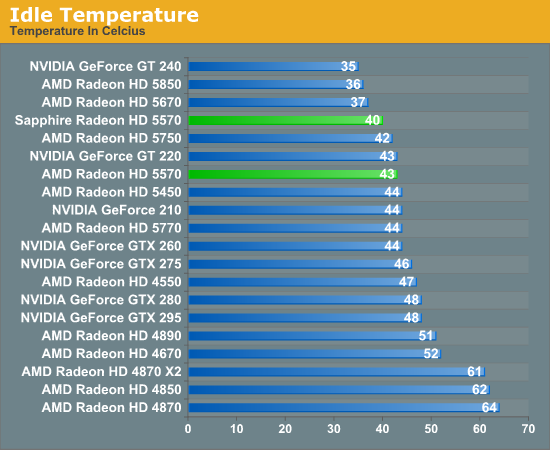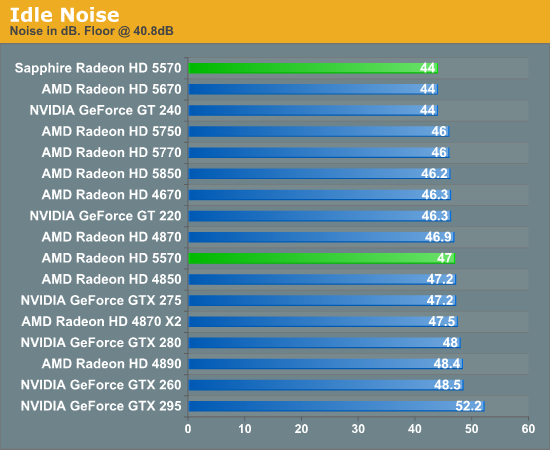AMD’s Radeon HD 5570: Low Profile, Higher Performance
by Ryan Smith on February 9, 2010 12:00 AM EST- Posted in
- GPUs
Power, Temperature, & Noise
As a note here, since NVIDIA does not offer a reference GT 240, we’re using our Asus 512MB GDDR5 GT 240 as our reference 240.


With a 42W TDP and 9.7W idle power rating, it should come as no surprise that the 5570 comes in between the 5450 and 5670 at both power measurements. The GT 240 is the biggest winner here, beating even the 5570. However this is likely due to differences in how AMD and NVIDIA throttle their cards under FurMark.
In terms of performance per watt, the 5570 falls in the same general range as the 4670 and the GT 240. This also gives us an idea of where the cut-off is for what can be done with a low-profile card – at 15W more under load, the 5670 basically marks the start of a whole new class of cards.


One thing you give up in moving to a smaller cooler for a low-profile card is the nice temperatures a full-profile card can attain. The 5570 ends up being several degrees warmer when idling when compared to the 5670, sharing company with our passive cards and some mid-range cards. Interestingly the Sapphire card does better here, coming in 3 degrees cooler at 40C.
Under load we have a different story. The 5570 marks a clear gap between passively cooled cards and actively cooled cards, but it enjoys the status of being our coolest actively cooled card. The Sapphire card on the other hand doesn’t do so well here, coming in at nearly 10C hotter. We believe that this is due to a combination of the difference in their fans and the use of a copper heatsink in the AMD reference card versus an aluminum heatsink in the Sapphire card. Unfortuantely we can’t tell which one has the bigger impact, since switching out a heatsink can improve the cooling performance without having an acoustic impact like switching out a fan does.
On a more speculative note, based particularly on the AMD card’s temperatures, the 5570 looks like a good candidate to get the passive treatment. It would likely need to be a full-sized card, but certainly it’s cool enough that someone should be able to build a passive Redwood card here.


Despite the number of cards with small fans in our collection, the AMD 5570 stands out as having one of the loudest. Not only is it loud enough to do a bit worse at idle than a number of other cards (all of which tend to hug the noise floor), but it has just the right pitch to sound loud. We can easily tell it apart from all the other fans in our Spedo case, something that isn’t the case with several of these other cards. The fan on the Sapphire card on the other hand is as quiet as anything else we have tested when it comes to idling.
Under load the AMD card continues to be at a disadvantage. The more power-hungry cards end up being louder, but it’s still louder than the 4670 and even the 5670 (the latter of which is a surprisingly quiet card). The Sapphire on the other hand bests the 5670, but remember that the cost of this is that the Sapphire card hits nearly 80C under load. Sapphire’s card is clearly tuned for acoustics over thermals.










36 Comments
View All Comments
andy o - Tuesday, February 9, 2010 - link
I think you mean "when ESVP is enabled" here:"it looks like AMD is hardcoding their drivers to disable certain post-processing features when ESVP is disabled"
andy o - Tuesday, February 9, 2010 - link
Ryan, I don't think this is such a big deal:"In our testing we didn’t notice any obvious playback issues with the 5450 or 5570 when we had ESVP disabled, but we’ve seen enough forum posts of this feature magically fixing poor video playback performance that we’re not confident enough to recommend disabling this feature. It’s something we think should be left enabled, at least for the time being."
I don't think there's any "magically fixing" for those people was probably done because of ESVP disabling post-processing features and nothing esoteric, so I think it's safe to assume that this aggressive disabling of feature by ESVP on these drivers is a bug, and you can safely disable it, and just enable some post-processing options you want, as long as you don't get choppy video or have issues with A/V sync.
I don't see how ESVP could affect smooth video playback more than what was explained by AMD (seems the forum user I mentioned on the 5450 thread was right about what it does). Once you have all the video frames showing in sync (no dropped frames), there's nothing more to make the video smoother besides using more post-processing to interpolate video and show it at higher refresh rates (which is clearly not happening here, and it would require a 120 Hz monitor at least.
juhatus - Tuesday, February 9, 2010 - link
Remember that AA absolutly kills this card? So whats the point showing it on the big table-results.How would it compare to other sub-100 cards without AA?
knowom - Tuesday, February 9, 2010 - link
Most cards bottleneck more with AA turned on and people tend to prefer having AA turned on as opposed to off when possible.juhatus - Tuesday, February 9, 2010 - link
3870 uses its shaders to do the AA, hence the bad AA results.16ROPS 256bit memory and ~400shaders shouln't compare too badly to this card without AA.
OCedHrt - Tuesday, February 9, 2010 - link
Per your numbers, the 5670 is 15W, not 25W, more under load.jigglywiggly - Tuesday, February 9, 2010 - link
This card is fail.Pino - Tuesday, February 9, 2010 - link
It´s perfect for me.I just play Day of Defeat Source and TF2, and I have a Dell Vostro 200 a low profile chassis, with a limited 200W PSU.
knowom - Tuesday, February 9, 2010 - link
Pretty much the GT 240 basically wipes the floor with it in terms of performance, power, and noise. I don't see any real selling points on this card even DX11 and Eyefinity don't seem too viable on such a castrated card performance wise.Get the GT240 instead or spend the extra $10-$20's on a better performance card or save yourself a $10-$15's on the quieter and more energy efficient one is what it boils down to.
mczak - Tuesday, February 9, 2010 - link
I think that's a bit harsh, though really the review was harsh I think in fact it was a bit unfair.- the lower power draw of the gt240 has no connection to reality. All other reviews (some of them measuring power draw directly, some at the wall) show the hd5570 has a quite a bit lower power draw than the gt240 ddr3 under load (at idle it's a wash), not to mention the gt240 gddr5 (or HD4670) which are even a bit higher. I strongly suspect either something was wrong with the sample card or measurement error (or rather, not keeping the setup consistent).
- the RE5 numbers are very puzzling, and I'd say they are just bogus. Toms also tested this game, and the HD5570 just behaved like in any other title (that is, close to HD4670) there. Seems a lot more believable.
- the comparison to gt240 gddr5 seems a tad unfair. Now AMD thinks this should be compared to gt220 which isn't really useful, but it seems to me that price-wise it will be really the same as the gt240 ddr3, not gddr5 version. Granted, that's probably only a 10 dollar difference but when talking about 80$ cards this does make a difference.